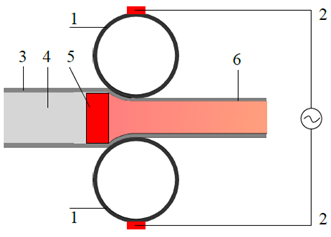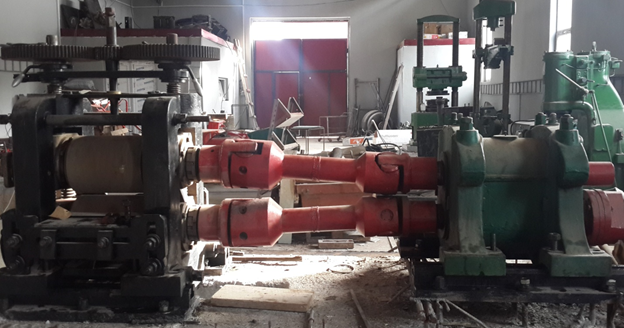Ongoing scientific research works in the laboratory include current problems existing in metallurgy-searching ways and solutions for making high quality products from metal-ceramic composite materials.
Material resources
Experimental workshop space of laboratory’s test base -345m2. A 3-ton crane is in the service of the laboratory.
Workshop holds:
1. Rolling mill-Duo280-Drive 17044 kw.
2. Rolling mill-Duo220-Drive 46kw.
3. Rolling mill-Duo150-Drive 33kw.
4. Injection-molding rolling machine 46kw.
5. Hydraulic press-500t.
6. Hydraulic stretching press-50t
7. Pneumatic hammer-25t
8. Electric heating oven-1200ch
9. Electric heating oven-1000ch
Main working directions of the laboratory:
1. Self-propagating high-temperature synthesis-Electric rolling;
2. Direct rolling;
3. Pressure processing of steel reinforced with nanoparticles;
4. Making cover and welding electrodes from metallic powders by pressure processing;
Research and treatment of special purpose product manufacturing from metal-ceramic composite materials using SHS-electric rolling innovative technology.
Research problems
The work is being carried out with coproduction of Self-propagating high temperature synthesis #5 laboratory.
Introducing, assimilating and processing highly demanded metal-ceramic composite materials of unique qualities and technology of getting relevant products from them is a pressing problem.
In order to solve this problem, SHS-electric rolling multi usable innovative technology is suggested, which allows to adopt a different purpose-protective, gradient, corrosion and wear and oxidization resistant tiles with energy saving, ecologically clean and high performance technology.
Currently SHS-electric rolling equipment is under reconstruction. The systems of transmissions number optimization from engine to rolls and instant adjustment of number of rolls rotation are designed and implemented in practice. It provides speed synchronization of rolling and SHS charge combustion front movement. SHS electric rolling machine will be equipped with the basic technological parameters of the computer and hold control gauges.
As a result automatic control system of SHS electric rolling process will be treated. The full stabilization of mutual correlation between parameters will be achieved. General technology of SHS electric rolling will be processed. Which will allow us to produce protective, gradient, corrosion, wear and oxidization resistant tiles with planned properties from different composition selected charges.
Pic.1 SHS electric rolling scheme
 |
1. Rolls; 2. Power supply electrical contacts; 3. Container; 4. SHS charge; 5. The combustion section; 6. The final product; |
Expected results
SHS electric rolling machine will produce pilot samples of tiles with ordered features from the relevant composition of charges. Recommendations will be processed for serial manufacturing of products with ordered features with SHS electric rolling machine. Treated technology report will be presented.
Commercialization potential
Protective, gradient, corrosion resistant, wear resistant and oxidization resistant tiles of metal-ceramic composite materials have a wide range of use because of their high physic-mechanical properties (Space, aircraft production, chemicals, agriculture, mechanic engineering). Hence the outcome of the work has the potential for commercialization.
Necessary resources
In order to perform work on a high scientific and technical level the laboratory has a whole complex of material and human resources. Work will be performed by highly trained engineers and scientists using SHS electric rolling machine created in the laboratory.
Improvement of physical and mechanical characteristics (Elasticity, viscosity, hardness) of special purpose steel using new nano-measurable composite ligature.
Research problems
Work is underway with the cooperation of #7 and #8 laboratories about chemical and chemical-physical analysis of inorganic materials. A project of powder nano measurable ligature blower into liquid steel equipment was processed. Injection is carried out in Argon stream.
The main reason for abrasion of internal surface of firearm barrel is the damage resulting from the combustion of gunpowder, having a negative impact on barrel steel’s important features such as elasticity, viscosity, and hardness.
The purpose of the work is to increase this characteristics by modification of barrel steel with nano measurable composite ligatures Fe-Al2O3, Fe-Ni-Al2O3, Fe- Al2O3,-Mo Co. Technology of making barrel steel from mentioned ligatures is intensively processed in the laboratory #8.
Research work is being carried out in the laboratory #2 in order to process manufacturing of barrel pieces from specific steel casts by rolling (establishing temperature, power and speed parameters, calibration of rolls), which provides strengthening and keeping of planned physical and mechanical properties.
Expected results
By modifying with obtained nano-ligatures CR-Ni-Mo special purpose steel was melt. As a result of steel rolling, limit ratio of fluidity and strength equaled 0.91, while of steel obtained without modification-0.72. This indicates that the steel modified with nano-ligatures has a significantly increased operational resource.
Treated steel has a wide range of use. Artillery barrels, oil propulsion, electrical power units.
Commercialization potential
According to the strategic plan of work development a business partner should be identified, market researches should be conducted, potential users of nano-powders should be revealed. Nano-powders industrial equipment should be started.

Processing the technology of making layered armor tiles on aluminum base with continuous casting and rolling method.
Research problems
At present Al-Mg; Al-Zn-Mg; Al-Zn-Mg-Cu system alloys are used as aluminum armor materials, which according to their mechanical qualities (Hardness, shock viscosity, plasticity) are used for various, however a limited purpose functions. Therefore it is topical to make anticorrosive composite layered armor tiles with universal properties, high strength and welding capabilities.
“Direct rolling” is the best method for this purpose, during which, using aluminum boron, carbon or basalt fiber reinforced slab as an intermediate layer seems prospective, in order to get three-layer armor slab.
Currently construction works for “Direct rolling” equipment modernization are underway. New nodes will be prepared and mounted, additional passer of technological parameters and the new management system will be placed. Practically a new experimental production type of “Direct rolling” aggregate will be created and casting-rolling technology of layered sheets will be processed on it.
Expected results
With the developed technology reconstructed cast-rolling laboratory mill will produce a high quality samples of layered metallic armor plates with reduced weight.
Assimilation of “Direct rolling” method will cost of energy resources by 6-7 times, and loss of metal by 5-6%. Ecological indicators will be improved significantly. Number of expensive rolling mills will decrease by 60-70%, in accordance with space necessary for their deployment.
Rolling production technology of aluminum sheets with necessary size (5-11 mm. thick) using direct rolling method will be treated and recommended.
Commercialization potential
Obtained materials can be successfully used for defense of light military equipment.
Necessary resources
Laboratory possesses material resources- Existing, experimental device of small dimensions, induction melting furnace, appropriate transducing and measuring equipment. A working draft of casting-rolling equipment with improved design and increased capabilities was processed. The device is being constructed, appropriate nodes are being searched and purchased. The work will be performed by highly qualified engineers and scientists.
Obtaining cover and welding electrodes by metallic powders pressure compaction and their testing in order to strengthen surfaces of details and restore geometric measures.
Work is being done in collaboration with the laboratory # 9
Research problems
Recovery of worn-out details, increasing their viability is naturally a pressing problem. Obtaining of cover and welding electrodes by metallic powders pressure compaction was processed in the laboratory. This significantly increases the performance of the process, simplifies the process, allows metal economy and expands the scope of its application. This method makes it possible to get the weld layers and surface coatings of desired thickness, restore geometric dimensions of details worn-out by exploitation and give necessary features to the surface-wear resistance, corrosion resistance, heat resistance and other. The project aims to create electrodes from different compositions (Iron, tungsten, cobalt, titanium) to test them for welding work pieces and surface covering by electric arc method.
Expected results
Compaction-sintering technology of powders will be processed. Electrodes used for restoring worn out details and giving their surfaces the necessary exploitation properties, will be obtained. Detail welding and surface coating recovery district will be designed on the testing base of laboratory, which will allow to produce electrodes with necessary properties.